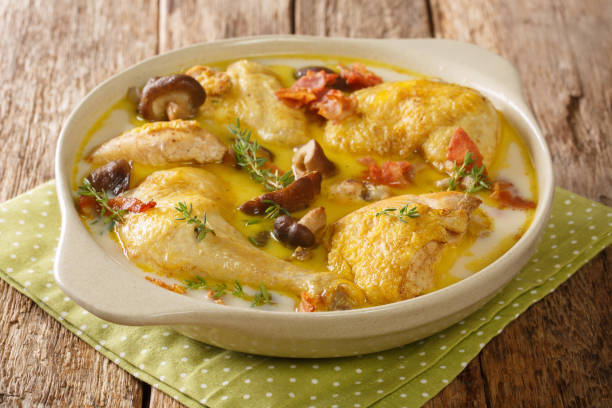
Chicken in White Wine Sauce
Pan searing chicken breasts until they are tender and perfectly brown is the best way to go. Next, finely chopped onions are sauteed to give them some color. Then, the bright white wine and chicken broth will be added. Finally, they will be simmered for a concentrated flavor. The sauce is finished with butter.
We don’t use any butter. We use the extra-luscious Danish Creamery Danish Style Butter Danish Creamery Danish Style Butter, which is slow churned to achieve a rich texture and velvety flavor.
This butter has remained the same recipe since 1985, which is something I absolutely love. It’s made with cream of high quality and sea salt.
The foil packaging means that no off-flavors can be imparted by the fridge. We want the butter to taste pure and without any additives.
It’s great for baking and buttering breads, but it can also be used to elevate your main course. This butter is perfect to pair with the bright flavor of this white wine sauce pan sauce.
This is a delicious dish that everyone will love!
Chicken in White Wine Sauce Recipe Ingredients
- 2 (12 oz.) skinless, boneless chicken breasts
- Salt freshly ground pepper
- 1/3 cup all-purpose flour
- 1 Tbsp Olive Oil
- 4 Tbsp Danish Creamery unsalted Butter cut into 1 Tbsp portions, then divided
- 1 small cup finely chopped yellow onions (1 cup)
- 2 tsp chopped garlic (2 Cloves)
- 1 1/2 cups + 1 Tbsp low sodium chicken broth, separated
- 1 cup dry white wine, such as Sauvigon blanc
- 2 tsp Thyme Leaves
- 1.5 tsp cornstarch
- 1 Tbsp chopped fresh Parsley
-
How to make Chicken in White Wine Sauce
-
- Cut the chicken breasts in half. Make 4 portions. To even out the thickness of the chicken breasts, wrap them in plastic wrap.
- Heat oil in skillet: Heat oil on 12-inch skillet at medium-high heat.
- Dice chicken: Put flour in a shallow bowl. Salt and pepper both sides of the chicken breasts. Then, dredge each side with flour. Remove excess flour by gently shaking off.
- Heat oil in a large skillet. If the skillet appears dry, turn the chicken over and drizzle with 1/2 Tbsp of olive oil.
- Transfer chicken: Place chicken on a plate. Cover with aluminum foil to keep warm.
- Heat half of the butter. Turn skillet on medium heat. Stir in 2 tablespoons butter.
- Saute onion and garlic. Then add onions to the pan and cook for about 5 minutes. Sauté garlic for 30 seconds more
- Add broth. Stir in the wine and thyme. Slowly add 1 1/2 cups chicken broth. Add the thyme leaves.
- Reduce heat and simmer the sauce. Let simmer for about 12 to 15 minutes, or until alcohol flavors have evaporated and the sauce is about 1/3 its original volume.
- Thickening sauce: Combine the remaining 1 Tbsp chicken stock with cornstarch in a small bowl until smooth. After the sauce has reduced in the skillet, add the cornstarch mixture to it and continue cooking for about one minute.
- Add the remaining half of butter to the sauce. Melt 2 Tbsp butter into the sauce. Salt and pepper to your taste.
- Return chicken. Garnish: Put sauce in skillet. Sprinkle sauce with parsley.
There are many possible variations
-
-
- Shallot Use 1/2 cup diced shallots instead of yellow onion
- Chicken thighs You can substitute the 4 chicken breasts with boneless 6 skinless chicken legs.
- Creamier sauce Reduce the amount of chicken broth by 1/4 Cup and replace it with 1/4 cup heavy cream. When you add the last 2 Tbsp butter, stir in the cream.
- Other herbs: You can substitute thyme with rosemary, chives, or tarragon.
-
These are some helpful tips
-
-
- Allow the sauce to simmer for at least 12 minutes so that the alcohol flavors can fully cook off. It will take 12 minutes. Don’t hurry it. Otherwise, you could ruin the wine’s flavors.
- Butter should be generously used. The butter balances the acidity in the sauce and gives the dish the desired richness.
- Sauté the garlic quickly. Garlic can easily burn and impart bitter flavors to any dish.
- Even chicken breasts can be used, provided they have been pounded with a meat mallet. This will ensure that certain areas don’t cook as fast as others.
- Don’t cook chicken breasts beyond 165°F. They can become dry and tough if they are cooked beyond that point.
-
-